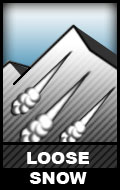Weekend Avalanche Outlook
Issued Friday, February 24, 2017 at 1:20pm:
*Heightened Avalanche Conditions*
Evaluate snow and terrain carefully; identify features of concern. Human triggered avalanches are possible; natural avalanches (except small sluffs or spindrift from steep terrain) are unlikely. Small avalanches in specific areas; large avalanches in isolated areas.
Keep in mind that flat light and low visibility from cloudy skies can greatly increase the difficulty of backcountry travel and avalanche hazard assessment.
Avalanche Problems:
Stubborn persistent slabs up to D3 in size are possible on steep (>35*) upper elevation (above 2500′) terrain on multiple aspects. Relative to other avalanche problems this weekend, these persistent slabs are lower probability but much higher consequence. These hard slabs may release unpredictably, allowing a human trigger to get well onto the slab before it releases from above and around, making escape difficult. Large persistent slabs could make for deep burial, and their hard slab characteristics will create more risk for casualty from trauma.
Persistent slabs are expected to be the most problematic on typically leeward aspects (which vary across the park) where there’s deeper snow, but shallow or unsupported “sweet spots” exist as trigger points. Steep terrain along leeward ridges and near peaks with sparsely protruding rocks (facet gardens), thinner snowpack areas (more human “stress bulb” penetration), or steep convexities (rollovers on slopes or cross loaded gully sidewalls with less compressive support) are expected to be problematic trigger points.
Two persistent weak layers are still exhibiting problematic results in snowpit tests: a layer of surface hoar (first identified here and here) buried by the February 9-10 snowfall that accumulated with light wind, and the advanced facets and depth hoar near the ground at the base of the snowpack. Review observations from the past week to get a better understanding of the persistent slab problem.
As always, practice “safe travel protocols.” Having an escape plan in mind will be especially prudent.
Touchy to stubborn wind slabs up to D2 in size are possible on steep (>35*) upper elevation (above 2500′) terrain on leeward aspects (which vary across the park, but are expected to be the most problematic on northerly aspects lee to recent southerly winds). The most prone areas to wind slab avalanche are expected to be wind loaded terrain near peaks and along ridges and cross loaded gullies.
Human triggered wind slabs this weekend are generally expected to be small and relatively soft, but it’s important to note that even a fall or loss of control caused by a small wind slab could result in serious consequences. Keep terrain traps and exposure in mind.
The wind slab problem is more predictable than the persistent slab problem. Pay close attention to the snow surface as you travel: notice how the density, texture, and depth changes. Wind slabs can be identified by areas of deeper and firmer snow, especially if it is “fat” or “pillowy” in appearance and/or feels “hollow” or “punchy” (denser wind slab overlying looser, weaker snow). Check out this observational video that has a short segment on identifying wind slabs. Quick snowpack assessment via pole-probing and handpits are effective means of grasping the wind slab problem and potential distribution.
A few inches of new snow Friday into Saturday could make for D1 natural and human triggered loose snow avalanches on steep (>35*), upper elevation terrain. While these will be small and aren’t inherently dangerous, practice effective “sluff management” and beware of terrain traps and exposure that could compound the consequences of a fall or loss of control. Be mindful of naturally triggered spindrift if climbing steep terrain.
As always, don’t approach a snowy ridge line to look down slope unless you’re sure it’s not corniced. Cornice falls are inherently dangerous, and they can also trigger an avalanche as they “bomb” the slope they fall onto. Give corniced ridges a wide berth; they have the potential to break further back than may be expected.
__________
Many avalanche accidents that have happened in Anchorage’s backyard of Chugach State Park could have been prevented by basic avalanche awareness. If you don’t have this level of awareness, here are some online resources to help you start the learning process. There are also numerous options for getting a real avalanche education locally.
__________
*click avalanche problem icons and hyperlinks for further info



